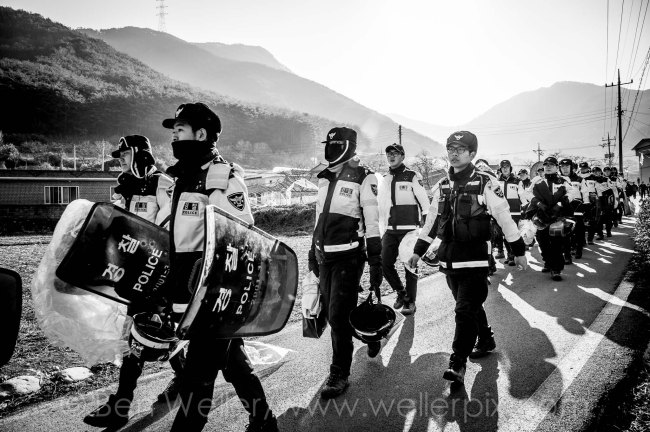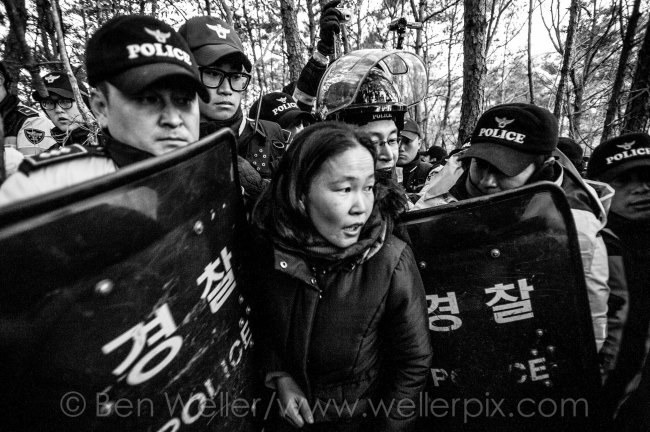I’ve lived the majority of the last 12 years in Busan, Korea’s second largest city, and I’ve witnessed the place change and grow in almost incomprehensible ways. Once quiet neighborhoods have turned into bustling hubs of economic activity; mountainsides have been reshaped into high-rise residences. The city has become bigger, taller, flashier, more accessible, and meaner, all at the same time. The dynamic has played out over and over in cities throughout the country.
Korea’s rapid economic growth demands enormous amounts of electricity, and it’s that demand that has met the fierce resistance of the farmers of Miryang, a small city 47 kilometers northwest of Busan. To these mostly elderly farmers, the most visible effect of “development” is not cell phones, flatscreen TVs, or air-conditioning. It is the high-voltage transmission towers that have sprouted along the ridges of their mountain valley.
Roads have been cut through their orchards, and trails dug out from the mountainsides, so that workers from the state utility, KEPCO, can reach the tower sites. The family burial sites of ancestors sit next to the crudely cut paths, in the shadow of towers. While some farmers have accepted buyouts from the state, many others have resisted, and this resistance has been met with force. The small farming villages of Miryang have come to resemble a police state.
I arrived in Miryang on January 25, traveling on a Hope Bus from Ulsan with a contact I had in the movement. The Hope Bus movement was born out of a labor solidarity action in Busan in 2011, and has spread as individuals and groups from around the country travel to sites of popular protest to show their support. The conflict in Miryang has drawn the sympathies of labor, environmental, and anti-nuclear activists, and on this day they had turned out by the thousands. Along with many local residents, including the farmers whose land is at issue, they would march peacefully from City Hall to the KEPCO office, and finally rally at Miryang Station.
When the rally ended on Saturday evening, I moved from Miryang Station to the village of Donghwajeon, along with a group of Hope Busers from the city of Daegu. Donghwajeon rests on the slopes of a wide valley, and above its modest homes sit orchards and burial plots. Snaking among them is a path up to the mountain ridge, where two transmission towers stand and another waits to be built. It was this site the protestors were trying to reach in the pre-dawn hours of January 26, when the group was blocked by riot police. The protestors immediately surged forward, pulling police one by one through to their ranks and attempting to break apart the human blockade.
In the darkness, I saw small groups of people begin to break off from the main group and scurry up the hillside away from the road. I followed behind as police chased after. We were headed toward the ridge, but in the darkness it was difficult to tell where we were, and there was no trail to follow. Instead, we followed the voices and shouts of those ahead of us.
After perhaps thirty minutes of hard climbing we reached the ridge, just as the sun was starting to rise. Amazingly, there was another large police force waiting for the protestors and blocking the path. Here, on top of a mountain in rural South Korea, riot police were ready to block locals access to their own land in the name of power and modernization.
The protestors argued with the police for an hour or so, asking why they weren’t allowed to pass, and sometimes attempting to push through. Finally, the people broke into song. They then turned and walked in the opposite direction, to one of the towers that has already been completed and waits to be connected to the others and, ultimately, to a new nuclear power plant–once the protesting farmers are bought-off, pacified, or removed.
The battle in Miryang is a familiar one wherever the demands of “development” clash with the call of tradition, the lives of the marginalized, and the property of the poor. The state has too much invested to let a small group of farmers and activists stop the project, but the passion and militancy of the opposition suggests that this struggle–already two years old–will continue for some time.
Park Chung-hee, the dictator who ruled South Korea from 1961 until 1979, is most often credited for building modern Korea. Under Park, the country underwent rapid industrialization through massive state projects and the suppression of labor and dissent. Today, his daughter, Park Geun-hye, is president, and the tensions between economic growth and democracy are still playing themselves out–in cities, in factories, and in the mountains of Miryang. As much as power lines and big cities have transformed this country, struggles like this one have also helped to form modern South Korea–a land where a dictatorship brought development, and an opposition built democracy.
Story and photographs by Ben Weller/www.wellerpix.com













